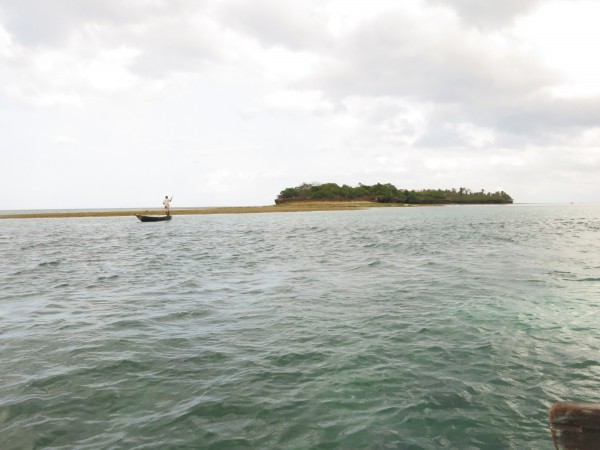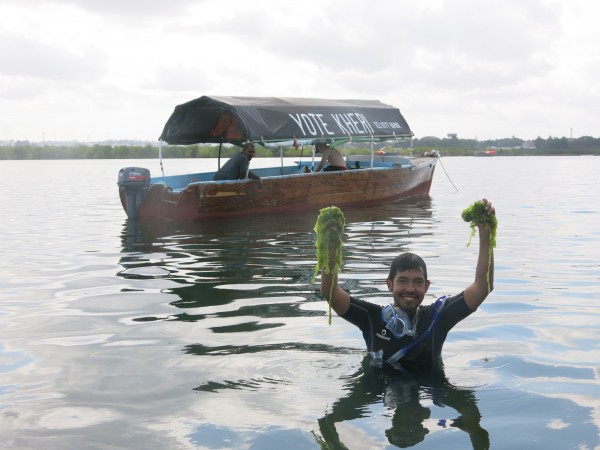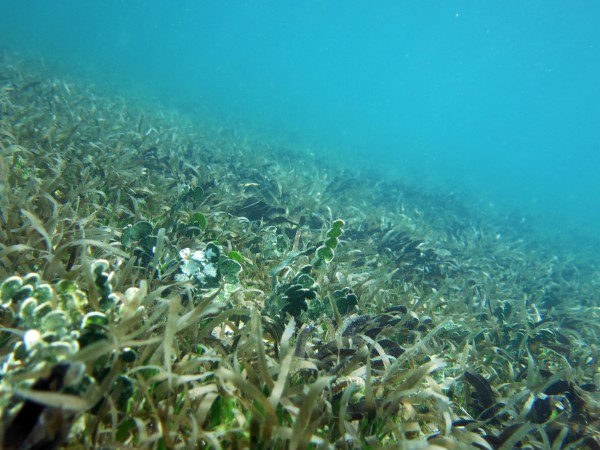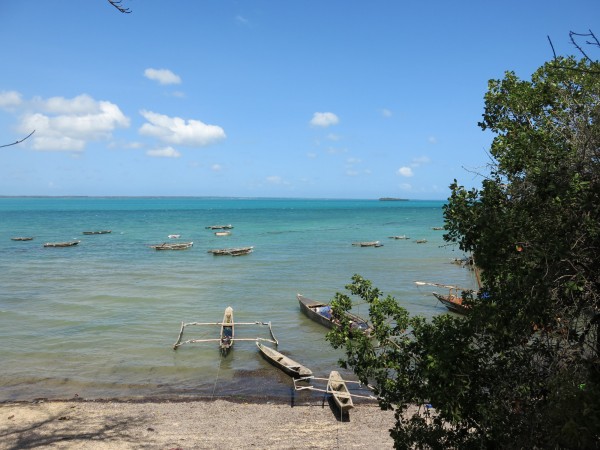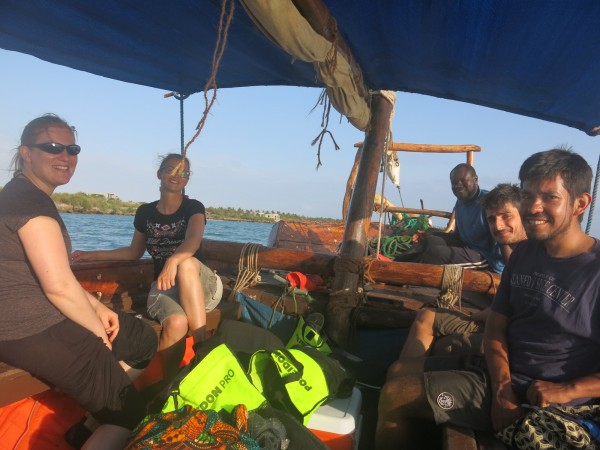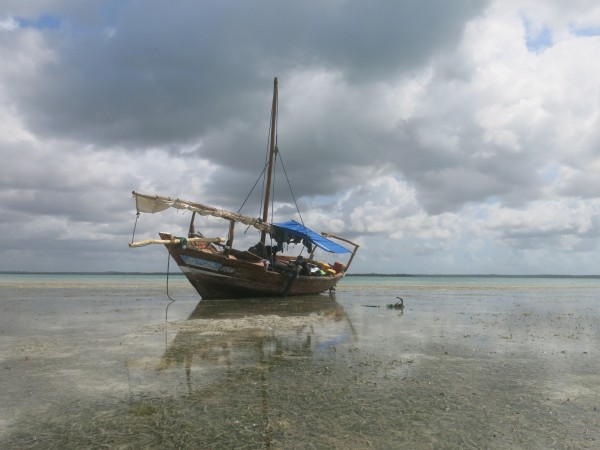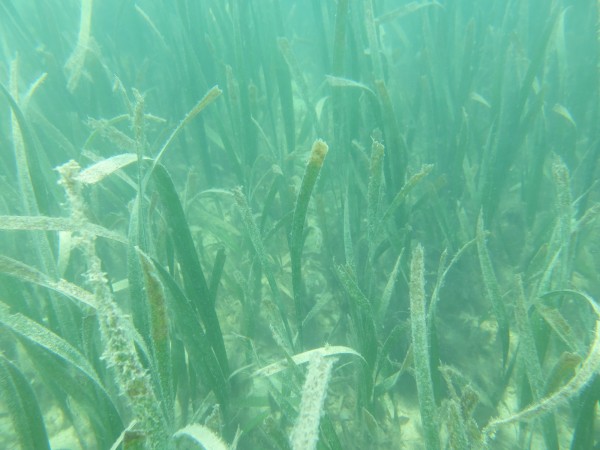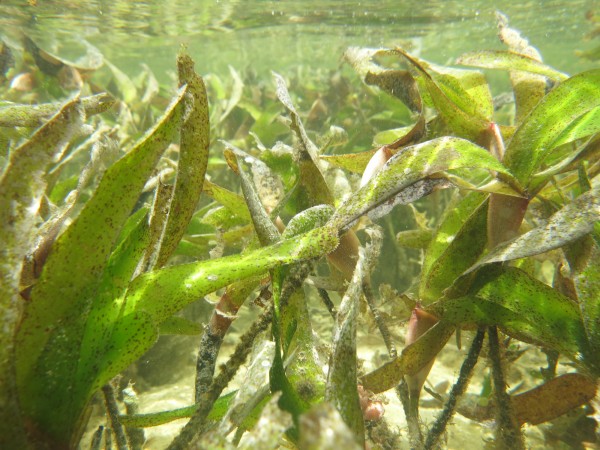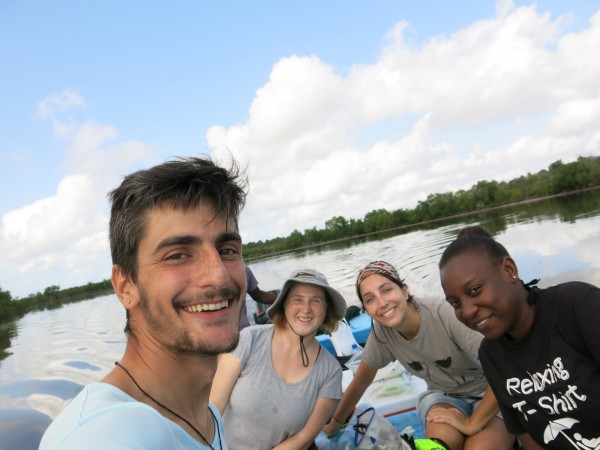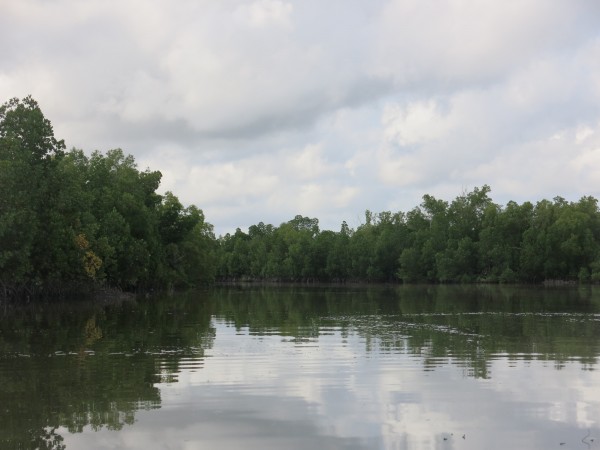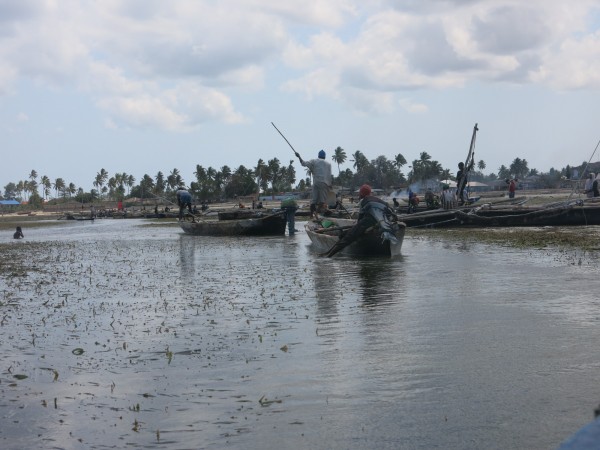Grave Island (Chapwani) in Stone Town area | Photo: Agustín Moreira
Dieser Text ist zur Zeit nur auf Englisch verfügbar...
The SEAMAC project (Seagrass and macroalgal community dynamics and performance under environmental change) aims to determine the environmental drivers influencing seagrass and macroalgal community dynamics, including anthropogenic increases in nutrient inputs to coastal waters, high sedimentation due to deforestation, and shifts in temperature and pH due to global climate
change. It is also important to understand the differences among seagrass and macroalgal species in their physiological responses and characteristic traits, which may allow certain species to outcompete other species under various environmental conditions. The first field site in the project we have visited is Zanzibar, Tanzania, which lies in the Indo-Pacific seagrass bioregion, with the highest biodiversity of seagrasses.
7.-14.10.16
Last but not least: Collecting samples for traits and interactions with local guides and boat drivers
For the last part of the expedition we took samples for measuring traits of almost all the seagrass species and some selected species of macroalgae present. We also took samples for morphological data as well as samples for biochemical data.
As a team, every day we are getting more and more efficient at taking samples, it was very nice to feel the nice work atmosphere and the good mood that everyone has in the group. The crew was made of mainly biologists and Ulrich Pint (the IT guy), everyone in the crew now has more expertise working in seagrass and algae species, than at the beginning, including Ulrich. Dieuwke taught him to identify algae species using the different morphology features of the species; for instance “the algae that looks like a small cactus” (Halimeda sp.), or “the fluffy algae” (Ulva sp.). He was also able to identify and sample seagrass species, when we mentioned to him “the spaghetti seagrass” (Syringodium isoetifolium) and “the wavy hand” (Thalassodendron ciliatum).
Beside the diverse leaf shape, it is also wonderful to observe the diverse green tones and intensities inside the seagrass meadows; each species has a green characteristic tone, for example the dark green of Enhalus acoroides, the light green of Cymodocea serrulata and the emerald green with brown dots of Thalassia hemprichii. I can´t wait to see the results of the biochemistry traits in relation to the traits the we see by naked eye.
We sampled in an area in the south of Unguja Island in a bay called Kiwani, we selected 2 places called Bweleo and Fumba. The places were not far away from each other, they have some seagrass meadows very different from each other, but both were very diverse in terms of species composition. The first day we were very fast taking the samples and we finished earlier, however when we wanted to move on, we realized that the boat was stuck because our boat driver put the boat over a sand bank and the tide was so low the boat was not able to float or to move. So we had to wait for 4 hours. Fortunately we had enough delicious fruits like pineapple, bananas and food like Chapati with peanut butter and nutella.
During the 2 days of sampling Mr. Ali, our local guide and translator, was very curious about the work that we were doing; the last day he was less shy and he finally talked to us and helped us with the sampling of biomass cores (which was very helpful because taking biomass cores requires a lot of physical strength).
The third day we worked in Prison Island and in the Mangrove-Harbour area. A really experienced boat driver named Ibrahim took us to both places on the same day. Dieuwke explained to him last year how to use the GPS compass, some people of the crew (except Dieuwke) were surprised for the accuracy of the GPS point that he took us. He calculated the rift velocity and direction and he located us directly to the point that the GPS was showing. Good job Dieuwke!!!
When I jumped into the water, it was nice to see macroalgae around as part of the seascape, the community composition was very different from one to another site; Prison Island has different species of macroalgae that differ in shape and colour, while in Mangrove-Harbour only Ulva sp. was present. I was happy to see again plants of T. hemprichii. This species really surprised me, because it can show different traits. It is a very plastic species that was present so far in all the areas and sites, growing in rocky substrate and also in very well developed sediment with different shapes.
The last day the sunny weather was not present and we got a nice surprising and refreshing tropical rain that made us feel more energetic and also showed us another face of the tropical sea land scape. Fortunately we did not have any problem sampling and with the last sampling our job for this expedition was successfully finished.
Daniel Saavedra, WG Algae and Seagrass Ecology and WG Mangrove Ecology
3. - 5.10.16
And it came the time to go to Chwaka Bay!
It is been already six months since I came back from Zanzibar, where I spent my fieldwork time for the master thesis, and Chwaka was my home for a couple of months. Coming back brought a lot of different feelings: remembering all the hard work and stress from the thesis, but also a lot of good memories from the people I got to know and the nice dawns as the sun was coming up from the waters of the bay.
Chwaka was the study area for a lot of researchers of the ZMT during the SUTAS project, and it is quite known for the extensive (very extensive!) seagrass meadows that you can find in the area. Nearly all the species present in Zanzibar can be found over there, and the landscape is absolutely unbeatable: clear waters, mangroves and all the fishing vessels sailing around.
In our case, Chwaka was quite interesting for two reasons. Firstly, the mangrove/seagrass connection in the mouth of the creeks running out of the mangroves makes it a perfect area to assess the interaction between these two ecosystems. Secondly, from previous studies it was shown that there is not a big anthropogenic impact in the waters. That is why it could be considered a quite pristine area for seagrasses.
All the team, together with Mondy (who was helping us all the way during the samplings) travelled to Chwaka and stayed in a small resort near the village. The change from the always-busy Stone Town to the calmness of the bay was, for sure, something all of us needed for a while. Nevertheless, that did not mean we were not going to work as hard as ever!
The day of the arrival was a crazy little mess packing everything and making sure that we had all prepared to settle a “field lab” in Inés´ and Mondy´s room (unfortunately for them, sorry girls!). After arrival, we had a very nice taste of Zanzibari cuisine from the hotel, and had the chance to spend a relaxed evening enjoying our dinner and resting for the following day.
In the morning we met with Hakim (my neighbor, boat driver and landlord during my time in Chwaka) to take the boats. The first field day took us to the mangrove area in the South of the bay. It is, definitely, an extremely beautiful area to work in. The mangroves present in the coast run deeply inside the land, joining together with Jozani forest (a National Park in Unguja), where you can see the two monkey species present in the island, being one of them (the Red Colubus) endemic of Zanzibar.
The work started with the collection of water samples and salinity data from the mouth of the mangroves creeks outwards, to assess the change in the water turbidity, nutrients and particulate matter from the mangroves. Then we settled the transects and the hard fieldwork started!
The dominant species was T. hemprichii, which seems to colonize every single corner of Zanzibar. Its plasticity and capacity to withstand different environments, substrates and conditions makes it an incredibly successful species in this island. Nevertheless, the most impressive characteristic of this area was the macroalgae biodiversity. Getting to catalog all the species in this area it will take us a long while, no wonder about that. The fieldwork day was long, as it was also the first “trait-sampling” day, thanks to the fact that we finally got the liquid nitrogen to shock-freeze all the samples.
Back in the hotel, maybe the longest processing time took place. Classifying ramets, pigments and enzymes samples, and also several selected algae species was tough and, especially, very time consuming. Inés and Mondy´s room looked like a war zone full of buckets with algae and seawater, bottles for the filtration unit, a liquid nitrogen container and a lot of people running around. I felt quite lucky that I was sleeping in another room, as I am quite a “tide-up” kind of person. Dinner took quite short this time as everybody was exhausted. I was even afraid someone would fall asleep in the table with their faces falling down on their plates.
The second day took us to an outer point in the bay, escaping from the mangrove influence and looking for a more oceanic area. While we were on the boats scouting around we all realized about the biodiversity of seagrasses in here. Every couple of meters you could encounter a new species, or a new type of mixed meadow; no wonder why Chwaka is a very studied area for seagrasses. At the end, we decided for a site in which nearly all seagrass species were present.
Even though the current was rough, pushing use while the tide was going down, the day ran very smoothly. The difference between the mangrove area and this one was very clear, showing lower algae diversity and several other seagrass species dominating the meadows. Also, there were plenty of sea urchins! As the sea urchin guy, I was very happy to see that. Unfortunately that also meant that Daniel and also I got stung by them in the feet (no worries, we are still alive).
After the fieldwork, it arrived the time to say goodbye to Chwaka. Our taxi driver, Ali, came to pick us up to go back to Stone Town. We made a short stop in the village so I had the opportunity to say goodbye to my former house-mates and Hakim, as I was not going to be able to come back (it is a quite jam-packed trip!).
While sitting in the taxi coming back to Stone Town, I started to think how interesting it will be to compare and understand the differences that we will see in the community structure and seagrass traits between Chwaka (quite pristine and with mangroves) to the other sites, were anthropogenic impact or exposure to the sea was higher. If we are lucky, this trip will show us how seagrasses (as Inés mentioned in the last post) can adapt to paradise and hell and, also, something in between.
Agustín Moreira Saporiti, WG Algae and Seagrass Ecology
27. - 29.9.16
After visiting the islands on the western side of Zanzibar, we headed south to Kiwani Bay near the villages of Fumba and Bweleo. These sites were very different from our other sites for a number of reasons. First, in Fumba, we found a site with high cover of the large seagrass Enhalus acoroides, the first site where we found this climax species, mixed with other faster growing species of Thalassia, Cymodocea, and Halodule spp. This site also had a high abundance and diversity of calcifying red and green algae, as well as the cyanobacteria Lyngbya. Although the seagrass community looked pretty intact, the turbidity was quite high and there also seemed to be a high number of epiphytes on the seagrass blades. That was surprising as there didn’t seem to be any source of obvious nutrient inputs nearby. Could there be some effect of nutrients from the mainland Dar es Salaam? That was an interesting question that we need to investigate further.
As we started our surveys, we were also surprised at the high number of fishes and noticeable bites on the leaves. This made the site an even more interesting area to study as fish were absent from all of our other sites. Could herbivory be high at this site? We found out from a local ranger who came to talk with us, that this area was a no take zone enforced by the local village. So this gave us the opportunity to evaluate the effectiveness of local management on the seagrass meadow. After a hard day of work, we left as the waves got too high and all of us were feeling a bit seasick.
The next day, we returned to the village of Bweleo just north of Fumba. Although the site was relatively close to Fumba, the seagrass community differed considerably due to the more noticeable impact of a branching red or brown alga that seemed to grow all over the seagrass bed. One of our IMS collaborators told us that this unknown alga has recently invaded the area, and has impacted also the seaweed farming in the region. What species is it and where did it come from? Is it native to the area but just recently bloomed, or was it introduced? These are questions that we will try to find out.
As we began working, the tide became so low, that the seagrass community was almost completely exposed to air and high light in the middle of the day. How could these seagrasses withstand such stress? We decided to take extra measurements of temperature, pH, dissolved oxygen, and salinity in the tidal pools during this time, to see how extreme the values reached. At the same time, the big wooden fisherman boat we were using as our base sat on the sand, waiting for the tide to come back in.
All in all, it was a great day, and the sampling was done fast as no diving or snorkeling was needed to get percent seagrass and macroalgal cover, biomass, and shoot counts. After finishing the sampling, we got back to shore and were followed by the local village children to the place where we were waiting for our ride, a big playing field, where the children played soccer and other outdoor games with their friends.
Mirta Teichberg, head of WG Algae and Seagrass Ecology
24. - 27.9.16
Seagrasses: Adapted to Hell and Paradise?
Today, it is one year since I first arrived to Bremen to meet the seagrasses, a group of marine plants unknown for me until the date. After several years working with macroalgae in temperate systems, I was about to start studying a small group of species -there are only 60 species of seagrasses worldwide. Therefore, Zanzibar, with 12 seagrass species living in their underwater ecosystems are considered to be a highly diverse area.
What I knew about them until the date was the important role that the seagrass ecosystems play in terms of habitat constructing, C storage or nutrient filtering, just a few examples of the services that they could provide us. I learnt also how sensitive they were: changing temperatures, increasing nutrient loading or changes in the light penetration due to an increase of particulate matter could potentially affect them. Therefore, they kind of deserved the nickname that we gave them during this year: the drama queens. But is this actually true? Seagrasses live in different areas under different environmental and anthropogenic pressures. So, how do they deal with that? That is one of the questions that we want to answer here in Zanzibar.
We settled in Stone Town, the most populated city in Zanzibar, where women covered by hiyab made with beautiful fabrics walk in the narrow streets full of grills with food, little stores, motorbikes and ringing bicycles (something in common with Bremen!). As it is always better to start sampling in the best known place, our first target were seagrass meadows in Stone Town area, where Dieuwke, Fay and Agustín have worked before. This area consists of a big sea extension limited in the land by a big harbor, very busy in the morning, and a mangrove area; and in the open ocean, by a fringe of beautiful islands with even more special names: Prison…, Snake… and Grave Islands. Difficult to choose one to stay!
We expected the nutrients and organic matter released both by mangroves and humans in the land area to be diluted once closer to the paradisiac islands, so we sampled during different days three different sites in a gradient from the land towards the ocean. Omi, our boat driver, took us to the first Paradise stop, Prison Island, a small island with some touristic cabins for a few lucky people and a lagoon that would also be a paradise for seagrasses. We set the transects and the work began: biomass and sediment cores, shoot counting, PAMming…a lot of tasks divided among the 7 people of the team.
The work for the divers and the snorkelers was intensive and the day was long…but we finished with all the work done! Back in the lab it was time for reflecting, we were all exhausted, so much new information for some of us! But thanks to the help of the expert ones we made it! But wait…what about the seagrasses? Well…they were not as good as we expected…the overgrazing event suffered last year (ask Agustin, the sea-urchin guy) and the elevated temperatures suffered earlier this year could have been too much for them, we could see as Thalassodendron ciliatum, normally moving as ballet dancers in the middle of the meadow where brownish and unhappy. In contrast, Cymodocea serrulata, Thalassia hemprichii and Syringodium isoetifolium (the Spaghetti seagrass) looked more relaxed and recovered from those events. Is the difference observed among them because the overgrazing of the sea urchins was mainly on T. ciliatum?
The following day, to make a bit contrast we decided to go to the harbor area. The spot selected was far away enough of one of the sewage pipes of the city to allow us to go into the water, but close enough to still detect the effects of the inputs on the seagrass community: no one wanted to live there! The ballet dancers (T. ciliatum), the Spaghettis (S. isoetifolium) were absent…not even Agustin´s sea urchins wanted to live there. Instead, loads of the Green bastards, as Dieuwke named the macroalgae Ulva sp. that completely covered all the meadow, were living in that neighborhood.
The seagrass survivors to the low light and excess particulate matter were C. rotundata and T. hemprichii, but with different characteristics to the ones observed in Prison, that atmosphere requires different “clothes”. So the unpretty place was particularly exciting to our scientific side! These different “clothes” are the different traits that seagrasses from different communities might change to adapt to different conditions…! They might be like indicators that something is going on there. Besides the excitement, once we finished our work, we left! We did not have those special traits to be there longer!
The following day, just to forget about the Hell, we went back to Paradise. A lot of happy species were growing at this second island, Grave: Halodule, Halophila ovalis, C. serrulata, T. hemprichii and C. rotundata with some macroalgal Gracilaria species growing where the seagrasses would let them. The day was cold and windy but whenever you would go underwater you would forget about all the inconveniences of the atmospheric conditions. Could we say this site is pristine?
Differences in community composition and individual traits along this nutrient gradient could be seen by naked eye. But, how do they adapt to these changes? And what would happen if besides one stressor, another one appears (as the overgrazing on T. ciliatum in Prison)? Could the seagrasses recover? We still need to wait to know that…
Inés Gonzalez Viana, WG Algae and Seagrass Ecology
23.9.16
Finally, today is the first day of preparation for the SEAMAC project after arriving to Zanzibar one week ago.
When we first arrived to Zanzibar, we spent a day or two adjusting to the new surroundings and checking out a few potential field sites. Then a whole crew of ZMT students and scientists joined for the SUTAS final workshop, where we met the partners and students at the Institute of Marine Science and ZMT east African alumni, and all presented results of previous studies and discussed future research.
After a few days of being led through the maze of small alleys of Stonetown by those who previously have been here, we finally all know our way around, or at least how to get to the IMS, the best restaurant in towns, and the ATMS machines. The members of the Algae and Seagrass Ecology group, Dieuwke Hoeijmakers, Daniel Saavedra Hortua , Agustín Moreira, Inés Gonzalez Viana, and I met at the Zanzibar Coffee house in the morning to discuss the plans for the field work and divide our tasks. After bringing all of our equipment and supplies to the IMS, we unpacked and began to set up our things in the IMS labs.
The rest of the scientific dive team, Uli Pint and Imke Podbielski, arrived today and met us at the station in the afternoon. After running all around town trying to find access to liquid nitrogen, dive tanks, and transect tapes, not such an easy task in Zanzibar’s relaxed city, finally, all was prepared for our first day in the field. We ended the evening at the local restaurant Lukmaan, which will probably be our main food supply during our trip where we can get a whole range of foods from samosas to chapati, potato and fish balls, beans and rice, assorted spiced and curried veggie and meat dishes. Yum. All still smiling, but exhausted, we went home to relax and sleep before the early morning boat ride to Prison island, our first field site on the Western side of Zanzibar.
Mirta Teichberg, head of WG Algae and Seagrass Ecology





